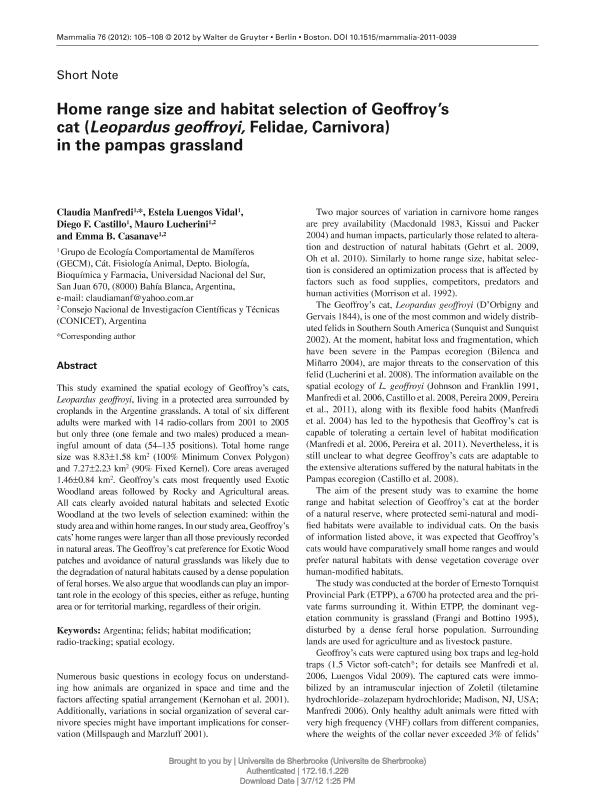Artículo
Home range size and habitat selection of Geoffroy’s cat (Leopardus geoffroyi, Felidae, Carnivora) in the pampas grassland
Manfredi, Matilde Claudia ; Luengos Vidal, Estela Maris
; Luengos Vidal, Estela Maris ; Castillo, Diego Fabián
; Castillo, Diego Fabián ; Lucherini, Mauro
; Lucherini, Mauro ; Casanave, Emma Beatriz
; Casanave, Emma Beatriz
 ; Luengos Vidal, Estela Maris
; Luengos Vidal, Estela Maris ; Castillo, Diego Fabián
; Castillo, Diego Fabián ; Lucherini, Mauro
; Lucherini, Mauro ; Casanave, Emma Beatriz
; Casanave, Emma Beatriz
Fecha de publicación:
02/2012
Editorial:
De Gruyter
Revista:
Mammalia
ISSN:
0025-1461
e-ISSN:
1864-1547
Idioma:
Inglés
Tipo de recurso:
Artículo publicado
Clasificación temática:
Resumen
This study examined the spatial ecology of Geoffroy's cats, Leopardus geoffroyi, living in a protected area surrounded by croplands in the Argentine grasslands. A total of six different adults were marked with 14 radio-collars from 2001 to 2005 but only three (one female and two males) produced a meaningful amount of data (54-135 positions). Total home range size was 8.83 ± 1.58 km 2 (100 % Minimum Convex Polygon) and 7.27 ± 2.23 km 2 (90 % Fixed Kernel). Core areas averaged 1.46 ± 0.84 km 2 . Geoffroy's cats most frequently used Exotic Woodland areas followed by Rocky and Agricultural areas. All cats clearly avoided natural habitats and selected Exotic Woodland at the two levels of selection examined: within the study area and within home ranges. In our study area, Geoffroy's cats ' home ranges were larger than all those previously recorded in natural areas. The Geoffroy's cat preference for Exotic Wood patches and avoidance of natural grasslands was likely due to the degradation of natural habitats caused by a dense population of feral horses. We also argue that woodlands can play an important role in the ecology of this species, either as refuge, hunting area or for territorial marking, regardless of their origin.
Palabras clave:
ARGENTINA
,
FELIDS
,
HABITAT MODIFICATION
,
RADIO-TRACKING
,
SPATIAL ECOLOGY
Archivos asociados
Licencia
Identificadores
Colecciones
Articulos(CCT - BAHIA BLANCA)
Articulos de CTRO.CIENTIFICO TECNOL.CONICET - BAHIA BLANCA
Articulos de CTRO.CIENTIFICO TECNOL.CONICET - BAHIA BLANCA
Citación
Manfredi, Matilde Claudia; Luengos Vidal, Estela Maris; Castillo, Diego Fabián; Lucherini, Mauro; Casanave, Emma Beatriz; Home range size and habitat selection of Geoffroy’s cat (Leopardus geoffroyi, Felidae, Carnivora) in the pampas grassland; De Gruyter; Mammalia; 76; 1; 2-2012; 105-108
Compartir
Altmétricas



